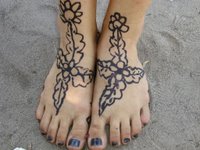One of the most striking contrasts I was able to register by pictures while in the Central African Republic was that of two feet that tread the same ground in Bayanga, the Pygmy area we were privileged to visit.
I notice the first feet the moment we entered the compound where a Swedish missionary family has lived for the last five years. I quickly surmised they were the feet of one of the missionary's daughters, a guess not too difficult to make, given that we were in the middle of Pygmy country and I knew that the missionary had five kids. I was struck by the beauty of the barefooted young girl who towered over the Pygmies she was standing side by side with.

(the beautiful feet of a European young girl)
Later I noticed that she also had tattoos in her arms and neck, made from natural henna extracted from the forest. I also noticed that a couple of other local girls also had tattoos on their bodies, not a fashion statement, but a children's game, resulting from having few toys and much nature to explore around them.
I played with these kids for about an hour and eventually shot a picture of the beautiful feet that tell a story of places and privileges that only a Western can claim. These feet are well groomed, even in the midst of Bayanga. They are clean and follow an almost perfect parallel pattern, show no signs of wear, and point to places yet to be visited.
These feet have been in the jungle, but they also have been around Europe, they have skied in the Alps and entered stores and places of learning. These feet open the door of opportunities and speak of a great past and a promising future. These feet invite you to join with them if only to have yours look a little better than they are. They are the golden feet of an European girl living in the end of the world. They look beautiful anywhere in the world.
Not long after finishing with the kids, I sat with a group of Pygmy young men who were admiring pictures from a digital camera one of our team mates was showing them. They were being introduced to the world the first feet belonged to: videos of the trolley at Detroit International Airport, tall buildings in Paris, airplanes at Charles de Gaulle Airport, electricity, restaurants, people looking happy everywhere.

(the man with the foot made of "stuff of life," on the left)
It was then that I noticed the feet of one of the men sitting across from me. They looked swollen, shrunk, distorted and older than its "owner." I immediately thought of the beautiful feet I had just photographed. There couldn't be a more pictorial lesson on the contrast between those who have and those who don't have. The feet I was now seeing spoke of an extremely rough life, lived close to the ground, mostly uncovered, open to the elements, to the dangers of crawling animals, deadly snakes, and flying machetes. Those feet looked like they had been tortured, which they, of course, were, not by men, but by the harsh realities of nature itself.

(the feet that gave me pause)
The feet of this Pygmy man pointed to no place in particular, except the mud of the ground, the harshness of life in the forest. These feet spoke of no privileged position in the world, but of toil and pain and groaning and prayers that went unheard for so long. These feet opened no doors and repelled everyone who was within their sight. These were no golden feet but feet made of the stuff of life. These feet were covered by the thick layer of flesh that now coated what once was an unsuspecting normal looking member of the body.
If you look carefully (click on the picture to enlarge, if you wish), there is a fly on the foot of the young girl as well as on the one of the Pygmy man; but while the one on the beautiful foot almost seems to augment the already ornate feet, the one on the harsh looking foot only augments one's sense of repulsion. It speaks of unsanitary places where one would dare not to walk. The fly almost seems like a bad omen, quietly doing its part in the deterioration of this body part, which already looks to be on life support.
Yes, I have to admit that I did feel repulsed at first, but it didn't take me long to realize that these were the feet of a survivor from Bayanga. That thought gave me pause. I felt a sense of deep respect, being in front of someone who, albeit young, had already been through so much. I was humbled to be in the presence of a man who had not given up and was still standing in spite of all the odds. Yes, his feet may have looked ugly, his sandals torn, but here was a man who would not give up on living. And now some of those prayers had been answered, as he had a chance to hear the good news that God loves him as much as He loves the European girl with the beautiful feet.
Next time you look at your feet, even if they are not that beautiful, think about how privileged you have been to live, work, and have fun in this part of the world we call the West. Think of what you would do if you traded places with that Pygmy man. And think about what you can do today to alleviate the suffering of some of the poorest of the poor around the world.
Pastor Ivanildo Trindade
No comments:
Post a Comment